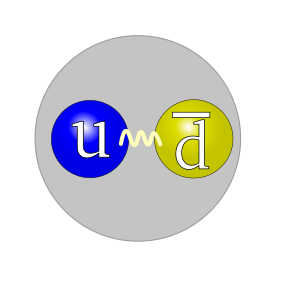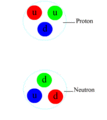Pion facts for kids
Pions (often called a π) are tiny particles. They are a type of meson. Mesons are special because they are made of two even smaller particles: a quark and an antiquark.
Antiquarks are like the "opposite" versions of quarks. If a quark and its matching antiquark meet, they can disappear in a flash! But this doesn't happen instantly. So, pions, like all mesons, can exist for a short time.
What makes pions special? They are always made of one up quark and one down quark. One of these will be an antiparticle. Scientists think pions are very important. They believe pions help create the strong force. This force holds nucleons (which are protons and neutrons) together inside an atom's center.
Contents
Different Kinds of Pions
There are three types of pions: π+, π–, and π0. The plus (+), minus (–), or zero (0) tells us about the pion's electric charge.
- A π+ (positive pion) is made of one up quark and one down antiquark.
- A π– (negative pion) is made of one down quark and one up antiquark.
Why are their charges like this? An up quark has a charge of +2/3. A normal down quark has a charge of -1/3. But an antiquark has the opposite charge of its normal quark. So, a down antiquark has a charge of +1/3. If you add +2/3 (up quark) and +1/3 (down antiquark), you get +1. That's why the π+ is positive! The same idea works for the π–.
A π0 (neutral pion) has no electric charge. It can be made in two ways:
- One up quark and one up antiquark.
- One down quark and one down antiquark.
Pions: The Force Messengers
Some particles are called force-carrier particles. They are responsible for different forces. For example, photons are believed to carry the electromagnetic force. This is the force behind electricity and magnetism.
Mesons, like pions, are thought to carry some of the strong force. This force is also known as the nuclear force. It acts between protons and neutrons inside the nucleus of an atom. At an even smaller level, gluons carry the strong force between quarks.
Pions are the lightest mesons. This is because they are made of the lightest quarks (up and down). Being light means they also live longer than most other mesons. However, like all mesons, pions will eventually decay, or break down.
How Pions Break Down
When pions break down, they always create leptons. Leptons are another type of tiny particle, like electrons.
- A π+ (positive pion) usually breaks down into one muon and one muon neutrino.
- A π– (negative pion) usually breaks down into one antimuon and one muon antineutrino.
- Neutral pions (π0) usually break down into two very energetic photons.
Other Ways Pions Break Down
Sometimes, pions can break down in slightly different ways. This happens with a small chance (less than 1.2%).
- For π+, the second most likely way to decay is into one positron (an anti-electron) and one electron neutrino.
- A π– will sometimes break down into one electron and one electron antineutrino.
- A π0 will sometimes break down into one energetic photon, one electron, and one positron. Remember that positrons and electrons can disappear when they meet. This creates a very energetic photon.
Why Pions Break Down (The Weak Force)
The breaking down of pions happens because of the weak force. This is another type of force in nature.
During this process, a special particle called a W+ boson is briefly created. It only lasts for an incredibly short time, about 3x10−25 seconds. After this tiny moment, the W+ boson breaks down into the leptons that the pion would normally decay into. This shows how the weak force is involved in pion decay.
Images for kids
-
An animation of the nuclear force (or residual strong force) interaction. The small colored double disks are gluons. For the choice of anticolors, see Color charge § Red, green, and blue.
See also
 In Spanish: Pion para niños
In Spanish: Pion para niños



